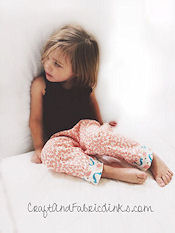Regulations: Not Designed For Children's Sleepwear
What Does That Mean?
 People have become increasingly concerned about safety, especially when it concerns our children. In the 1970's a new
flammability ruling was created, stating that fabric sold for children's sleepwear and children's clothing sold as sleepwear must
meet flammability standards, or be clearly marked as "not suitable for children's sleepwear" (if it appeared to be a sleepwear type item). If the
fabric did not pass flammability tests, it would need to be treated with fire retardant. People have become increasingly concerned about safety, especially when it concerns our children. In the 1970's a new
flammability ruling was created, stating that fabric sold for children's sleepwear and children's clothing sold as sleepwear must
meet flammability standards, or be clearly marked as "not suitable for children's sleepwear" (if it appeared to be a sleepwear type item). If the
fabric did not pass flammability tests, it would need to be treated with fire retardant.
Many people were unhappy with these standards because they preferred natural fibers such as cotton, rather than polyester (chemically treated or not), and they did not like the the addition of chemicals to the clothing that their children would be wearing to bed. Due to public pressure, the
standards have been changed from the original rules. As of this writing (2005), these rules apply to sleepwear sizes 9 months to 14.
The US Consumer Product Safety Commission (CPSC) now states (as of this writing, 2005, and when I rechecked the government website in 2015):
1. The fabric and garments must pass certain flammability tests, or
2. be "tight fitting" as defined by certain dimensions.
The reason for "tight fitting" is that loose garments are more likely to come into contact with a flame.
Go to cpsc.gov: Consumer Product Safety Commission requirements for sleepwear. I used to list the link to their file, but the file is no longer at that link. You should still be able to find the information on the website.
Is Chemical Treatment Permanent?
Chemicals can wash out over time
Various chemicals are used in making items more fire resistant and many wash out over time. I looked up one such chemical and the company stated that it lasted for 50 washings. How many people actually count the number of washings and then throw away the garment when it reaches that number? According to the government document in the first section above (CPSC), three different areas are tested (fabric, prototype trim and seam areas and production garment trim and seam areas), and they are tested at production (or after one washing) and again after 50 washings. One maker of fire retardant stated on their website that their fire retardant was "non-toxic" but it also stated that "treated fabric is permanently fire resistant provided the goods are not laundered." Obviously, this type of fire retardant could not be used on fabric that will go into children's sleepwear.
What Should You Do?
Learn the facts
For further questions, contact the Consumer Product Safety Commission. Learn the benefits and risks regarding the use of various fabrics. Do you feel safer using a fabric that passes flammability tests, or would you prefer to use natural fibers and follow "tight fitting" standards?
CraftAndFabricLinks.com Fabrics (Our store is currently closed)
Children's Fabrics
Our fabrics are all 100% cotton unless otherwise noted. NONE of our fabrics are "suitable for children's sleepwear" according to their manufacturers. This means that you must keep the garment tight fitting if it is to be used as sleepwear.
Shop Safely - Be Happy!
|

 People have become increasingly concerned about safety, especially when it concerns our children. In the 1970's a new
flammability ruling was created, stating that fabric sold for children's sleepwear and children's clothing sold as sleepwear must
meet flammability standards, or be clearly marked as "not suitable for children's sleepwear" (if it appeared to be a sleepwear type item). If the
fabric did not pass flammability tests, it would need to be treated with fire retardant.
People have become increasingly concerned about safety, especially when it concerns our children. In the 1970's a new
flammability ruling was created, stating that fabric sold for children's sleepwear and children's clothing sold as sleepwear must
meet flammability standards, or be clearly marked as "not suitable for children's sleepwear" (if it appeared to be a sleepwear type item). If the
fabric did not pass flammability tests, it would need to be treated with fire retardant.
